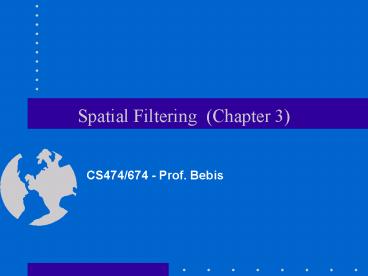Spatial Filtering (Chapter 3) - PowerPoint PPT Presentation
Title:
Spatial Filtering (Chapter 3)
Description:
Filters Filters Smoothing Filters: Averaging (Low-pass filtering) Smoothing Filters: Averaging (cont d) Smoothing Filters: Averaging (cont d) ... – PowerPoint PPT presentation
Number of Views:130
Avg rating:3.0/5.0
Title: Spatial Filtering (Chapter 3)
1
Spatial Filtering (Chapter 3)
- CS474/674 - Prof. Bebis
2
Spatial Filtering Methods (or Mask Processing
Methods)
3
Spatial Filtering
- The word filtering has been borrowed from the
frequency domain. - Filters are classified as
- Low-pass (i.e., preserve low frequencies)
- High-pass (i.e., preserve high frequencies)
- Band-pass (i.e., preserve frequencies within a
band) - Band-reject (i.e., reject frequencies within a
band)
4
Spatial Filtering (contd)
- Spatial filtering is defined by
- (1) A neighborhood
- (2) An operation that is performed on the pixels
inside the neighborhood
5
Spatial Filtering - Neighborhood
- Typically, the neighborhood is rectangular and
its size - is much smaller than that of f(x,y)
- - e.g., 3x3 or 5x5
6
Spatial filtering - Operation
Assume the origin of the mask is the center of
the mask.
for a 3 x 3 mask
for a K x K mask
7
Spatial Filtering - Example
- A filtered image is generated as the center of
the mask moves to every pixel in the input image.
8
Handling Pixels Close to Boundaries
pad with zeroes
0 0 0 .0
or
0 0 0 .0
9
Linear vs Non-LinearSpatial Filtering Methods
- A filtering method is linear when the output is a
weighted sum of the input pixels. - Methods that do not satisfy the above property
are called non-linear. - e.g.,
10
Linear Spatial Filtering Methods
- Two main linear spatial filtering methods
- Correlation
- Convolution
11
Correlation
g(i,j)
12
Correlation (contd)
Often used in applications where we need to
measure the similarity between images or parts of
images (e.g., pattern matching).
13
Convolution
- Similar to correlation except that the mask is
first flipped both horizontally and vertically. - Note if w(x,y) is symmetric, that is
w(x,y)w(-x,-y), then convolution is equivalent
to correlation!
14
Example
Correlation Convolution
15
How do we choose the elements of a mask?
- Typically, by sampling certain functions.
16
Filters
- Smoothing (i.e., low-pass filters)
- Reduce noise and eliminate small details.
- The elements of the mask must be positive.
- Sum of mask elements is 1 (after normalization)
17
Filters (contd)
- Sharpening (i.e., high-pass filters)
- Highlight fine detail or enhance detail that has
been blurred. - The elements of the mask contain both positive
and negative weights. - Sum of the mask weights is 0 (after
normalization)
18
Smoothing Filters Averaging(Low-pass filtering)
19
Smoothing Filters Averaging (contd)
- Mask size determines the degree of smoothing and
loss of detail.
3x3
5x5
7x7
original
15x15
25x25
20
Smoothing Filters Averaging (contd)
Example extract, largest, brightest objects
15 x 15 averaging
image thresholding
21
Smoothing filters Gaussian
- The weights are samples of the Gaussian function
s 1.4
mask size is a function of s
22
Smoothing filters Gaussian (contd)
- s controls the amount of smoothing
- As s increases, more samples must be obtained to
represent - the Gaussian function accurately.
s 3
23
Smoothing filters Gaussian (contd)
24
Averaging vs Gaussian Smoothing
Averaging
Gaussian
25
Smoothing Filters Median Filtering(non-linear)
- Very effective for removing salt and pepper
noise (i.e., random occurrences of black and
white pixels).
median filtering
averaging
26
Smoothing Filters Median Filtering (contd)
- Replace each pixel by the median in a
neighborhood around the pixel.
27
Sharpening Filters (High Pass filtering)
- Useful for emphasizing transitions in image
intensity (e.g., edges).
28
Sharpening Filters (contd)
- Note that the response of high-pass filtering
might be negative. - Values must be re-mapped to 0, 255
sharpened images
original image
29
Sharpening Filters Unsharp Masking
- Obtain a sharp image by subtracting a lowpass
filtered (i.e., smoothed) image from the original
image
-
30
Sharpening Filters High Boost
- Image sharpening emphasizes edges but details
(i.e., low frequency components) might be lost. - High boost filter amplify input image, then
subtract a lowpass image.
(A-1)
31
Sharpening Filters Unsharp Masking (contd)
- If A1, we get a high pass filter
- If Agt1, part of the original image is added back
to the high pass filtered image.
32
Sharpening Filters Unsharp Masking (contd)
A1.9
A1.4
33
Sharpening Filters Derivatives
- Taking the derivative of an image results in
sharpening the image. - The derivative of an image can be computed using
the gradient.
34
Sharpening Filters Derivatives (contd)
- The gradient is a vector which has magnitude and
direction
or
(approximation)
35
Sharpening Filters Derivatives (contd)
- Magnitude provides information about edge
strength. - Direction perpendicular to the direction of the
edge.
36
Sharpening Filters Gradient Computation
- Approximate gradient using finite differences
37
Sharpening Filters Gradient Computation (contd)
38
Example
39
Sharpening Filters Gradient Computation (contd)
- We can implement and using masks
(x1/2,y)
good approximation at (x1/2,y)
(x,y1/2)
good approximation at (x,y1/2)
- Example approximate gradient at z5
40
Sharpening Filters Gradient Computation (contd)
- A different approximation of the gradient
good approximation
(x1/2,y1/2)
- We can implement and using the
following masks
41
Sharpening Filters Gradient Computation (contd)
- Example approximate gradient at z5
- Other approximations
Sobel
42
Example
43
Sharpening Filters Laplacian
The Laplacian (2nd derivative) is defined as
(dot product)
Approximate derivatives
44
Sharpening Filters Laplacian (contd)
Laplacian Mask
detect zero-crossings
45
Sharpening Filters Laplacian (contd)
Sobel
Laplacian































